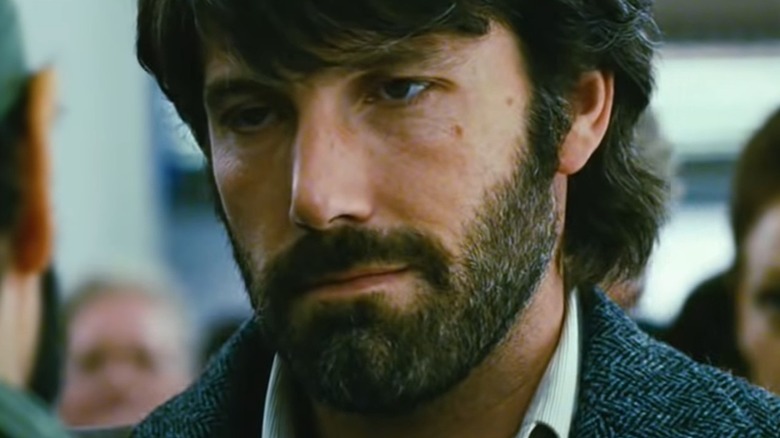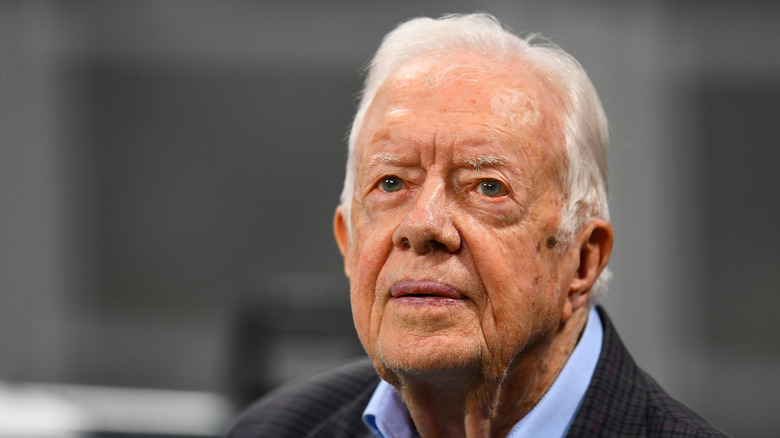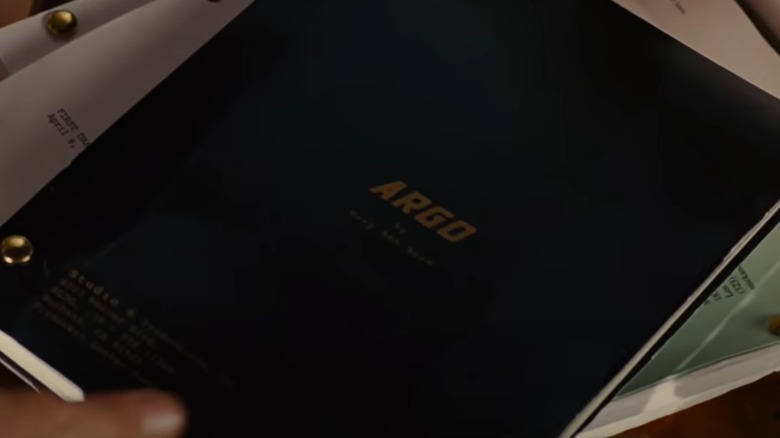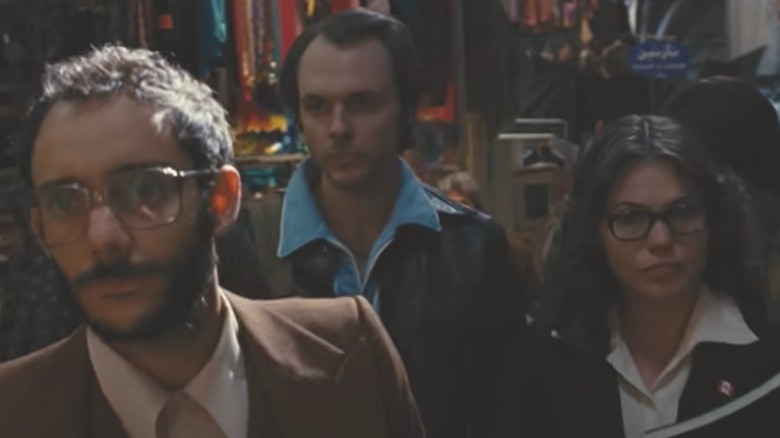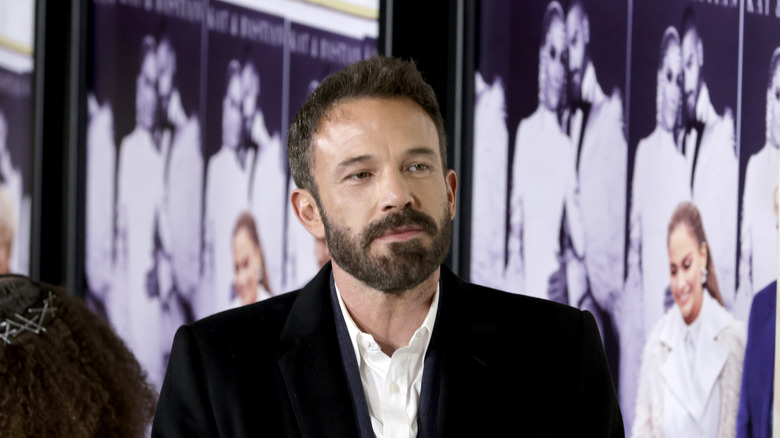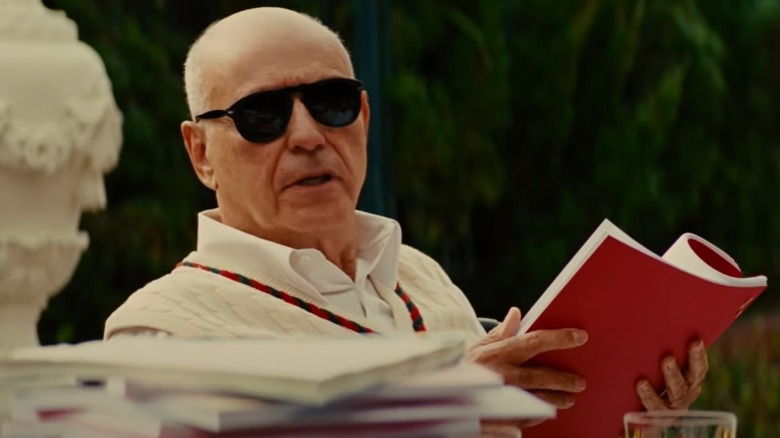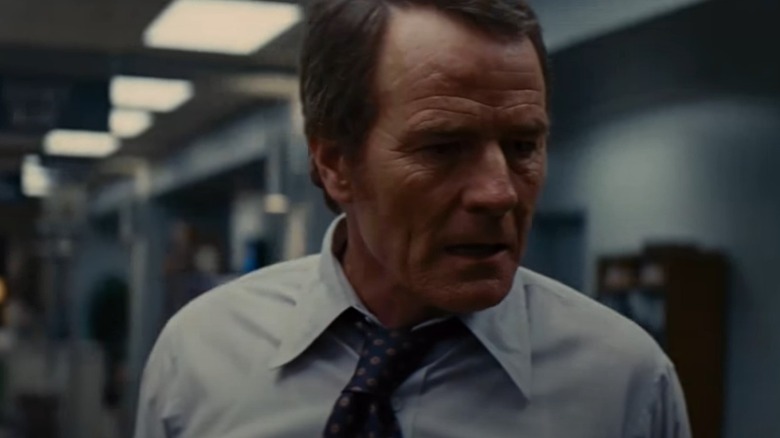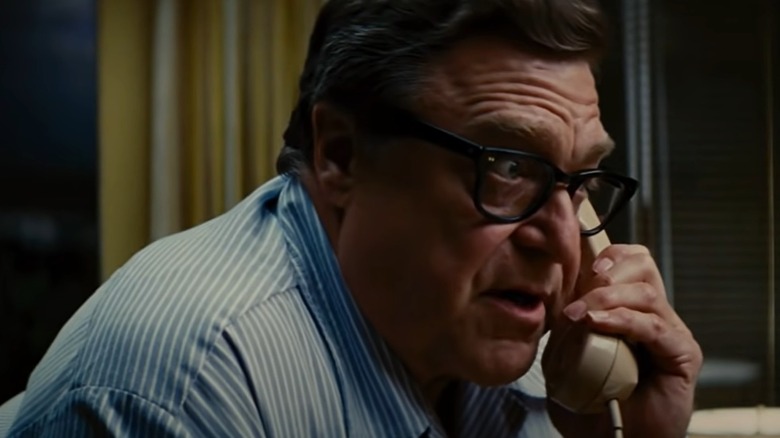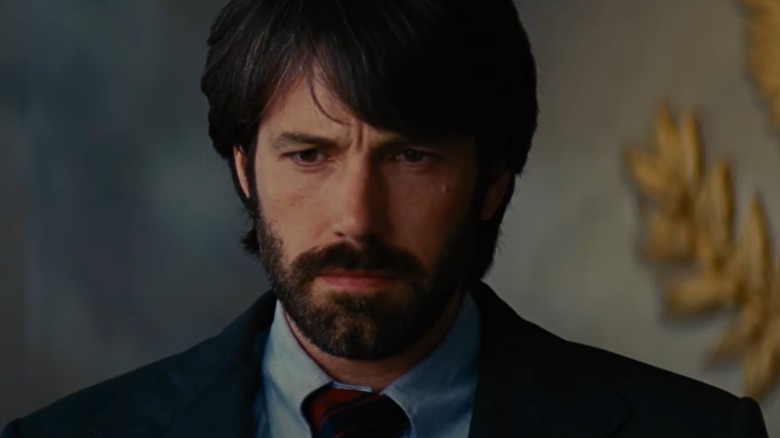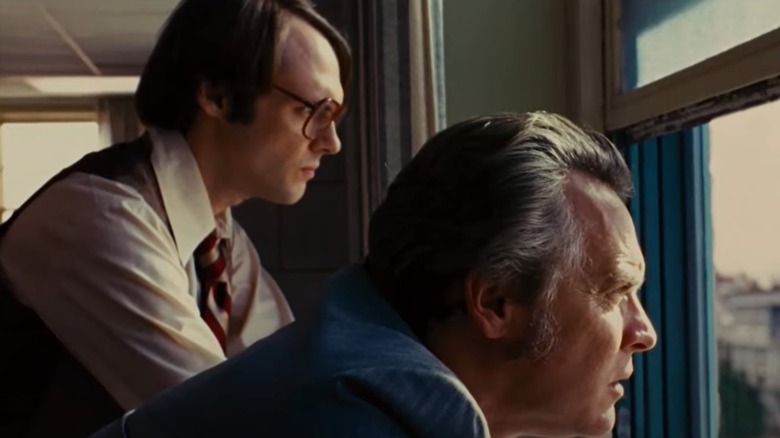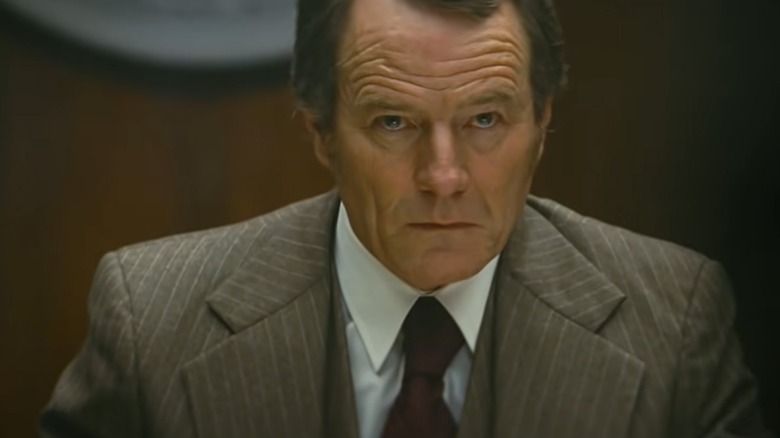The Untold Truth Of Argo
The ups and downs of Ben Affleck's career have been well documented. For every film like "Gigli" and "Pearl Harbor" that are best forgotten about, there are the likes of "Good Will Hunting" and "Gone Girl" that rank as some of the best films of their respective years. Affleck is just as good in front of the camera as he is behind it: He has directed, written and produced several films (not counting a short film he made in 1993), starting in 2007 with "Gone Baby Gone" and continuing in 2010 with "The Town."
His third feature was the 2012 film "Argo." Not only was the film a big commercial success, but it also won the Oscar for Best Picture. One of the best thrillers you can find on Netflix, the film is based on a true story, and like many true stories, there are both many interesting facts about what really happened, and some creative liberties taken in order to make the story cinematic.
Here are some facts about "Argo" you may not have known.
The real events that led to the Canadian Caper
In 1979, anti-American sentiment in Iran reached a boiling point thanks to the combination of President Jimmy Carter's support of the deposed Shah Pahlavi and the rise of militant leader Ayatollah Ruhollah Khomeini. When President Carter allowed Pahlavi into the United States for medical treatment, things took a turn for the worst. A group of college students who supported Ayatollah stormed the U.S. Embassy in Tehran and took over 60 American citizens hostage. The Americans were released in 1981 after being held for 444 days, with the event becoming known as the Iranian Hostage Crisis.
During this crisis, six of the American diplomats were able to escape with the help of CIA agent Tony Mendez, who posed as a film producer scouting locations for a new movie. They were sheltered by Canadian officials before being rescued by the CIA in what would become known as the Canadian Caper. These are the events that are portrayed in "Argo," albeit a very loose adaptation of these events.
Argo is an adaptation about a fake adaptation
The film "Argo" is adapted from two different sources: A Wired magazine article titled "The Great Escape," and Tony Mendez's memoir "The Master of Disguise." As both sources tell it, Mendez needed to make his team's story about being a Canadian film crew as plausible as possible in order to rescue the hostages. Mendez and his team eventually stumbled upon a script for a film called "Lord of Light."
The script was adapted from the 1967 novel of the same name by Roger Zelazny. The novel is an epic science fiction tale about a lone hero who must battle against a group of technologically advanced beings that refer to themselves as gods. When the CIA acquired the script, they changed the name to "Argo" and the rest is history.
As great as it was that the CIA was able to use the script to save American lives, it's also a shame that the actual film never got made. Who knows? "Lord of Light" could have been the next great science fiction franchise alongside "Dune" or "Star Wars."
The CIA tweeted about the film several times
Since "Argo" is an adaptation, obviously certain things are going to be changed when translated onto film. Luckily, the Central Intelligence Agency was there to help distinguish what really happened and what didn't. Around the 35h anniversary of the Iran hostage crisis, the CIA released several tweets about what was "real" and what was actually "reel" (a reference to a film reel, meaning what was created for the film).
These tweets revealed a lot about the events that happened in the movie, some of which will be discussed later in this article. One interesting thing the CIA revealed was that a very dramatic scene in the film never actually happened. In the film, Mendez and the diplomats travel to a bazaar to "scout locations" for their fictional movie in order to make their cover story more believable. In reality, the diplomats never traveled there.
Tony Mendez is Hispanic, Ben Affleck is not
Not only is Ben Affleck both director and producer, he also plays the starring role of Tony Mendez. Mendez worked for the CIA for over 20 years before retiring in 1990. After writing several different books, including ones about the Canadian Caper that were used as references for "Argo," Mendez passed away from complications with Parkinson's disease in 2019 at the age of 78.
"Argo" is a nice tribute to his legacy, but his portrayal by Affleck drew some criticism. Mendez is of Mexican ancestry, which Affleck does not have. This has led to accusations of whitewashing, as any number of Mexican actors could have portrayed Mendez and could have possibly contributed to more positive representation for Mexican protagonists.
Mendez has stated that he "doesn't consider himself Hispanic," but that hasn't stopped actors like Edward James Olmos from criticizing Affleck still to this day for his portrayal.
Lester Siegel isn't real
Another crucial step that went into making sure that the "Argo" film-within-a-film seemed legitimate was getting the backing of a major Hollywood producer. Mendez went to Lester Siegel, played by Alan Arkin. Like many people that Mendez brought his idea to, Siegel thought that pretending to make a film was a terrible idea, but still went along with it. Arkin's performance as the foul-mouthed producer was widely praised, and even landed him an Academy Award nomination for Best Supporting Actor.
Arkin's character might be great, but he also doesn't actually exist. In an interview with The Hollywood Reporter, Arkin explained that Siegel was actually a composite character. When creating the character, Arkin stated that he used Jack Warner, one of the co-founders of Warner Bros. (the studio that actually distributed the film), as a basis.
"He's someone who is very comfortable in his own skin," Arkin said to THR, "someone who knew the ins and outs of the business, backwards and forwards."
There was already a film about the Caper
Ben Affleck's cinematic version of the Canadian Caper wasn't the first time the events were portrayed in film. Back in 1981, CBS released the television movie "Escape From Iran: The Canadian Caper." There are two key differences between the events in "Argo" and the events in the television film. The first is that "Escape From Iran" focuses mostly on Canadian ambassador Ken Taylor (played by Victor Garber in Affleck's film) and the embassy's role in saving the hostages. The second is that Tony Mendez and his "Argo" plan aren't mentioned at all.
Though not confirmed, this is most likely because the Canadian Caper wasn't declassified by the CIA until 1997, as shown in "Argo" when Mendez was set to receive an award in secret for his service but immediately had to give it back. "Escape From Iran" was released only a few months after the hostages were rescued.
The films that John Chambers worked on
One of the first people that Mendez went to in order to get his plan running was John Chambers, a make-up artist who helped Mendez make a fake production company and spread awareness for the film they weren't going to make. After serving in the U.S. Army in World War II as a dental technician and making some prosthetics for veterans, he started working as a make-up artist for both film and television around the 1950s.
Chambers did the make-up for several of the biggest science fiction films of the '60s and '70s, with some of his work even going uncredited. His most famous works include creating the pointed ears for Spock in the original "Star Trek" series and the prosthetics used in the original "Planet of the Apes" movies, where he won an Honorary Oscar for his work (the Best Makeup Oscar didn't exist until 1981). Some of his other works include "Jaws," "Halloween II" and "Blade Runner." Chambers eventually retired in 1982 and passed away in 2001.
Not only was Chambers a gifted and influential make-up artist, he was also an American hero.
Bootleg DVDs of the film were very popular in Iran
Since "Argo" takes place in Iran, and depicts a part of that nation's history that doesn't make it look very good, the Iranian government wasn't too keen on seeing the film. In fact, "Argo" was outright banned in the country, and the government decided to make their own film depicting the events of the crisis. According to the article, the Iranian version is meant to show how the American hostages weren't mistreated as badly as the Ben Affleck version suggested.
But that doesn't mean that those living in the country didn't get a chance to see it. There were several reports that "Argo" became very popular thanks to the booming underground DVD market. Bootleg DVDs aren't anything new, but the article states that the people who were purchasing these DVDs were doing so as a form of protest against the government's hostilities towards America.
The USA had help, which the film didn't properly show
Living in fear for your safety isn't easy, and luckily the American diplomats had the help of Canadian ambassador Ken Taylor to protect them. But one interesting fact that is left out of "Argo" is that the Canadians weren't the only ones who aided them. In the beginning of the film when Mendez is being briefed on the situation by Jack O'Donnell (Bryan Cranston), he states that both the British and New Zealand embassies turned the American diplomats away before the Canadians took them in.
But that didn't actually happen. Both British and New Zealand diplomats helped a great deal (via The Guardian) in both keeping the Americans safe and getting them out of the country. Not only that, but the Daily Mail reported that the British embassy did briefly house the diplomats before the Canadians did, while New Zealand diplomats helped get the Americans to the airport on time.
The stakes weren't that high for the hostages
"Argo" ends with Mendez escorting the six diplomats through the airport and onto the plane without the Revolutionary Guard figuring out who they are. The real-life Mendez reminisced about getting the Americans out in an interview with NPR, alongside former U.S. Agriculture Department employee Lee Schatz. Both talked about how tense it was getting the diplomats to safety, but the film actually exaggerates much of the danger of getting on the flight.
In the film, the identities of the diplomats are discovered, and a chase scene occurs after everyone boards the plane. Though the authorities did try to stop them in real life, the plane had already taken off before they could do anything. But the diplomats never went through that kind of danger, nor a chase scene that didn't actually happen.
As overdramatic as it might be to include a chase scene that wasn't actually there, it does give the film a gripping finish that would otherwise make the ending anticlimactic.
